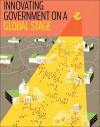SPONSORED SUPPLEMENT TO SSIR
Innovating Government on a Global Stage

This special supplement includes nine articles produced for the Open Government Partnership. OGP is a new effort to foster greater transparency and accountability, improve governance, and increase civic engagement worldwide.
-
Transforming Multilateralism: Innovation on a Global Stage
-
Shattering Decades of Diplomatic Protocol
-
Innovating Modern Democracy, in Brazil and Globally
-
Advocacy from the Inside: The Role of Civil Society
-
The UK’s Transparency Agenda
-
Tanzania’s Transparency Agenda
-
Philanthropy Can Catalyze an Open Government Movement
-
India in Open Government and Open Government in India
-
Building a Global Norm on Open Government
On September 20, 2011, 46 world leaders, including US President Barack Obama and Brazilian President Dilma Rousseff, lined up for a “family photo.” Diplomats are accustomed to such things—an awkward three-minute shuffle when the world’s most powerful stand shoulder-to-shoulder and smile for the camera. But this photo op was different: Standing together with leaders of nations were leaders from civil society organizations from around the world.
The moment’s symbolism was not lost on those who had spent the previous 12 months working toward the launch of the Open Government Partnership (OGP), an initiative that has shattered decades of precedent in diplomatic protocol.
When the idea of OGP first made its way through the corridors of the US State Department in the early days of 2011, many were skeptical. Multilateral initiatives are ubiquitous and often ineffective. Open government is a relatively new term in the vocabulary of foreign policy. And questions of corruption and accountability are older than democracy itself. The possibility of creating an initiative that would catalyze government transparency and accountability was, understandably, a long shot.
For OGP, the stars aligned, and it went from an idea to an international headline to a good governance roadmap in less than a year. Today, 58 OGP countries have joined OGP, making commitments that will affect two billion people. A testament to US Secretary of State Hillary Clinton’s vision of 21st-century statecraft, OGP has broken the mold of international engagement primarily in two ways: first, by creating a global platform for interaction among domestic reformers; and second, by establishing an unprecedented principle of parity between government and civil society in the management and direction of a major policy agenda.
Everyone involved understood that for OGP to succeed, it needed to go beyond the US State Department and foreign ministries, to the agencies and reformers immersed in the sticky challenges of battling domestic corruption, enhancing transparency, and supporting citizen participation. In early 2011, we at the State Department had a skeleton list of our own reformers, but not every government was able to identify a roster as quickly. Many reformers are career public servants buried deep in bureaucracy. And their location varies greatly from one country to the next. In Brazil, Minister Jorge Hage leads his government’s battle against corruption from the Office of the Comptroller General, whereas in the Philippines, Minister Florencio “Butch” Barsana Abad is advancing government transparency from the Ministry of Finance and Budget.
OGP has broken the mold of international engagement by creating a global platform for
domestic reformers and by establishing parity between government and civil society.
OGP’s challenge, and its goal, is to identify champions within government agencies and elevate them to an international stage through a network of like-minded reformers committed to improving the transparency and accountability of governments. OGP offers a second pathway for international engagement: It is a partnership not just among nations, but also between governments and civil society. From the governance of OGP to the development, implementation, and monitoring of country commitments, civil society sits side-by-side with governments at every stage of the initiative. This shift is a break with the past—in which accountability advocates had a critical, even antagonistic, relationship with governments. OGP affirms through its structure and its work that sustainable progress on critical issues can be made only by working pragmatically across sectors.
Of course, we cannot expect this shift to happen overnight, nor will it succeed in every country. Even at the level of OGP’s 18-member steering committee—where you will find OGP’s most committed champions— challenges persist. Governments and civil society organizations operate within distinct cultural norms. Bureaucrats rotate to other jobs, making it difficult to retain institutional memory and enthusiasm. Meanwhile, civil society representatives are more consistent and often very well informed about critical issues. The result is a delicate, ever-shifting dynamic among representatives who together drive OGP forward. But no matter the sensitivities, the reward already has proven to be far greater: a thoughtful policy agenda followed by action and accountability.
Although it remains to be seen whether OGP will create long-term impact through country action plans, the initiative has already succeeded in setting new, high expectations for results-based collaboration. We hope that its example of leveraging domestic champions and including civil society has set a new precedent for future international efforts.
Support SSIR’s coverage of cross-sector solutions to global challenges.
Help us further the reach of innovative ideas. Donate today.
Read more stories by Maria Otero & Caroline Mauldin.

